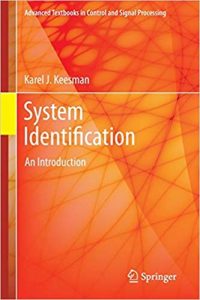نام کتاب: System Identification – An Introduction
نویسنده: Karel J. Keesman
ویرایش: ۱
سال انتشار: ۲۰۱۱
کد ISBN کتاب: ۰۸۵۷۲۹۵۲۱۷, ۹۷۸۰۸۵۷۲۹۵۲۱۷
فرمت: PDF
تعداد صفحه: ۳۲۳
انتشارات: Springer-Verlag London
Description About Book System Identification – An Introduction From Amazon
System Identification: an Introduction shows the (student) reader how to approach the system identification problem in a systematic fashion. Essentially, system identification is an art of modelling, where appropriate choices have to be made concerning the level of approximation, given prior system’s knowledge, noisy data and the final modelling objective. The system identification process is basically divided into three steps: experimental design and data collection; model structure selection and parameter estimation; and model validation, each of which is the subject of one or more parts of the text.
The book contains four parts covering:
· data-based identification – non-parametric methods for use when prior system knowledge is very limited;
· time-invariant identification for systems with constant parameters;
· time-varying systems identification, primarily with recursive estimation techniques; and
· model validation methods.
The book uses essentially semi-physical or grey-box modelling methods although data-based, transfer-function system descriptions are also introduced. The approach is problem-based rather than rigorously mathematical. The use of finite input–output data is demonstrated for frequency- and time-domain identification in static, dynamic, linear, nonlinear, time-invariant and time-varying systems. Simple examples are used to show readers how to perform and emulate the identification steps involved in various model applications, as control, prediction and experimental design, with more complex illustrations derived from real physical, chemical and biological applications being used to demonstrate the practical applicability of the methods described. End-of-chapter exercises (for which a downloadable instructors’ Solutions Manual is available from www.springer.com/978-0-85729-521-7) will both help students to assimilate what they have learnt and make the book suitable for self-tuition by practitioners looking to brush up on modern techniques.
Graduate and final-year undergraduate students will find this text to be a practical and realistic course in system identification that can be used for assessing the processes of a variety of engineering disciplines. System Identification: an Introduction will help academic instructors teaching control-related courses to give their students a good understanding of identification methods that can be used in the real world without the encumbrance of undue mathematical detail.
درباره کتاب System Identification – An Introduction ترجمه شده از گوگل
شناسایی سیستم: مقدمه خواننده (دانش آموز) را نشان می دهد که چگونه به روشی منظم به مشکل شناسایی سیستم نزدیک شود. در اصل ، شناسایی سیستم هنر الگوسازی است ، در جایی که با توجه به دانش قبلی سیستم ، داده های پر سر و صدا و هدف نهایی مدل سازی ، باید انتخاب های مناسبی در مورد سطح تقریبی انجام شود. فرایند شناسایی سیستم اساساً به سه مرحله تقسیم می شود: طراحی آزمایشی و جمع آوری داده ها. انتخاب ساختار مدل و برآورد پارامترها. و اعتبار سنجی مدل ، که هر یک موضوع یک یا چند بخش از متن است.
این کتاب شامل چهار بخش است:
· شناسایی مبتنی بر داده ها – روش های غیر پارامتری برای استفاده در هنگام دانش قبلی در سیستم بسیار محدود است.
· شناسایی زمان ثابت برای سیستمهایی با پارامترهای ثابت؛
· شناسایی سیستم های متغیر زمان ، در درجه اول با تکنیک های تخمین بازگشتی. و
· روش های اعتبار سنجی مدل
این کتاب در واقع از روشهای مدل سازی نیمه بدنی یا جعبه خاکستری استفاده می کند اگرچه توضیحات سیستم عملکردی مبتنی بر داده و انتقال نیز معرفی می شوند. این رویکرد مبتنی بر مسئله است نه ریاضی دقیق. استفاده از داده های ورودی و خروجی محدود برای شناسایی فرکانس و زمان دامنه در سیستم های ایستا ، پویا ، خطی ، غیرخطی ، زمان متغیر و زمان متغیر نشان داده شده است. مثالهای ساده برای نشان دادن چگونگی انجام و تقلید مراحل شناسایی در برنامه های مختلف مدل ، به عنوان کنترل ، پیش بینی و طراحی آزمایشگاهی ، استفاده می شود که تصاویر پیچیده تری از کاربردهای فیزیکی ، شیمیایی و بیولوژیکی واقعی برای نشان دادن کاربرد عملی استفاده می شوند. روشهای توصیف شده تمرین های پایان فصل (که برای آن یک کتابچه راهنمای راه حل مربیان قابل بارگیری از طریق سایت www.springer.com/978-0-85729-521-7 در دسترس است) هر دو به دانش آموزان کمک می کنند تا آنچه را که آموخته اند ، جذب کنند و کتاب را مناسب سازند. خودآموزی توسط پزشکانی که به دنبال ترکیه در فنون مدرن هستند.
دانشجویان دوره کارشناسی ارشد و کارشناسی ارشد سال آخر این متن را به عنوان یک دوره عملی و واقع بینانه در شناسایی سیستم می دانند که می تواند برای ارزیابی فرآیندهای انواع رشته های مهندسی مورد استفاده قرار گیرد. شناسایی سیستم: مقدمه به مربیان آکادمیک کمک می کند تا دوره های مربوط به کنترل را آموزش دهند تا دانش آموزان خود را در مورد روش های شناسایی که می توانند در دنیای واقعی بدون وارد کردن جزئیات ریاضی ناعادلانه به کار روند ، درک کنند.
[box type=”info”]![]() جهت دسترسی به توضیحات این کتاب در Amazon اینجا کلیک کنید.
جهت دسترسی به توضیحات این کتاب در Amazon اینجا کلیک کنید.![]() در صورت خراب بودن لینک کتاب، در قسمت نظرات همین مطلب گزارش دهید.
در صورت خراب بودن لینک کتاب، در قسمت نظرات همین مطلب گزارش دهید.

